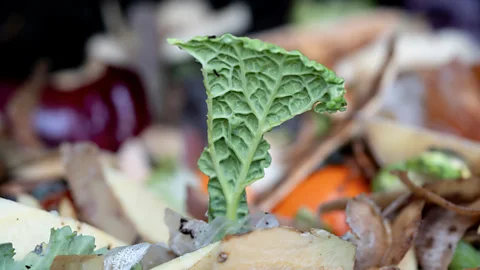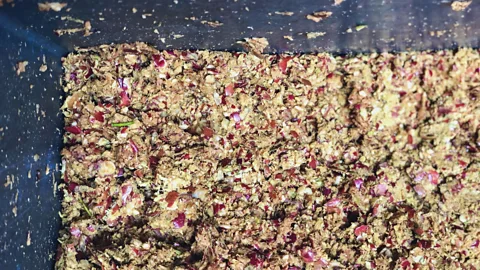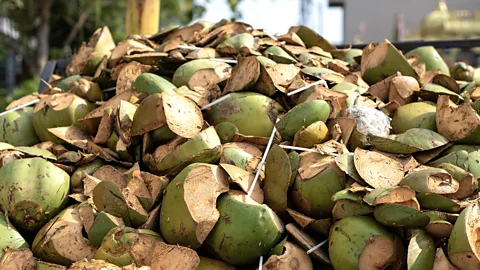The waste food upcycled into new products
_0slmYW2MGA_a1gjiztsznglyaxuuhakr3yuotgsbmlzb4decydy8c0meccg13s4qpwtahj9_nwinq3IhVi_ncyrgehnollnbttom4imvbi2s8za5cyz8yqkiecerb4rwntwfkzqpo10wvag.png)
The waste food going to landfills is an invisible but important part of greenhouse gas emissions. Could discarded scraps be turned into new food instead?
In a two-storey building on the harbour at Refshaleøen, Copenhagen, there is chocolate being tempered in the kitchen; upstairs, plates of tacos and protein bars are being served. This isn't the opening of the latest small plates restaurant, but the brainchild of Rasmus Munk – the two Michelin-starred chef on a mission to "upcycle" what we eat.
Munk is one of a growing number of people who believe the future of food lies in what we're already throwing away. With nearly 8% of global greenhouse gas emissions caused by lost or wasted food (more than three times that caused by the aviation industry), and almost 40% of all food grown in the US each year thrown away, they hope upcycling – using discarded scraps to help create new food – can tackle the world’s burgeoning edible waste mountain.
And so at Spora, the lab a few hundred metres from Munk's restaurant, Alchemist, the chocolate is made from cocoa husks (approximately three-quarters of each cocoa pod is discarded when beans are harvested for chocolate). The tacos, meanwhile, are filled with rapeseed cakes, a high-protein byproduct left over when rapeseed oil is made.
The lab was born out of experiments conducted at Alchemist, which prioritises using often-ignored animal products like jellyfish or chicken heads (deep-fried and entirely edible; they grace one of the 50 dishes he serves up to diners each night), and cow's udders, which "taste a little bit like parmigiano". "To turn some of these products that you normally just discard or throw out [into] something that's delicious is for me very important, based on a perspective of making a more sustainable future," says Munk.
 Getty Images
Getty Images
Food that goes to landfill releases methane, one of the most damaging greenhouse gases (Credit: Getty Images)
Unsold or uneaten food is the single-most common material found in US landfills, with the methane released causing biodiversity loss, rising air pollutants and soil degradation.
In June, the US Environmental Protection Agency and the US Department of Agriculture released their final National Strategy for Reducing Food Loss and Waste and Recycling Organics, outlining ambitions to halve food loss and waste by 2030. While efforts until now have focused on the production and disposal of foods, international bodies are waking up to the idea that repurposing, rather than recycling, may be a more effective solution.
Companies seem to be waking up to it, too. In 2021, the upcycled food product market was worth £42bn ($53.7bn); it will hit £76bn ($97bn) by 2031.
"Interest is growing a lot," says Simona Grasso, assistant professor in food science and nutrition at University College Dublin, who is soon to welcome her first PhD student focusing on upcycling. "I think it's a very hot topic," she says, while acknowledging the research is in its infancy.
\
At start-ups across Europe, the US and Asia, used food products are currently being given a second life
Within the food industry, momentum is growing to change that. The Upcycled Food Association, a nonprofit working to prevent food waste, launched in 2019 with the belief that "upcycling presents a unique solution globally"; in the past five years, they have gone from working with nine companies to more than 240 today. They have also rolled out a certification system that flags to consumers which products use ingredients that "otherwise would not have gone to human consumption, are produced using verifiable supply chains, and have a positive impact on the environment".
In June, at the Towards Halving Food Waste in Europe conference, the Upcycled4Food Initiative was announced, pledging the transition "from a niche market to widespread use and procurement of upcycled ingredients and products".
And so at start-ups across Europe, the US and Asia, used food products are currently being given a second life in the form of bread, pasta and supplements made from the 40 million tonnes of spent grain typically discarded from beer production; coffee grounds (of which 54 million tonnes are thrown out each year) are being re-spun into gin, flour and energy bars.
 nibs etc
nibs etc
Apple waste left over from juicing is used by nibs etc to make crackers and granola (Credit: nibs etc)
Coconut flesh, otherwise binned when extracting the water, is now being scooped out and transformed into yoghurt, while fruit and vegetable skins are making their way into dried snacks and juice.
Last year nibs etc, which uses apple pomace (the pulpy residue left over when fruit has been crushed to make juice) launched in cracker and granola form on shelves at Selfridges and Whole Foods in London. They are "25% upcycled, so [there's] loads of natural fibre in that", says Chloë Stewart, its founder. Other products currently in development include biscuits, baking flours and puff snacks.
"The connection between wasted food and climate change is severely misunderstood and underestimated," she believes. The environmental benefits aren't only reducing the amount of food that is going to landfill (and thus the amount of methane released), but "alleviating the pressure on existing supply chains to grow new ingredients and new foods that are, for example, high in fibre or protein".
Most of those companies behind the products currently in development are operating at a small scale
The nutritional density these byproducts provide both lightens the load "on our already broken food system," and adds value to products that have already been grown, Stewart adds, as they make full use of the water, energy and human resource poured into what has already been producedA paper published last year in the journal Trends in Food Science & Technology found that "mainstreaming the idea of upcycling in food systems has huge potential for improving circularity in the food system".
But there remain lags in consumer understanding, Stewart says, noting that in the US, people seem more aware of the concept than in the UK. Jessica Aschemann-Witzel, a professor at the University of Aarhus who co-authored the paper, says that "we found that most of the research shows that when people are environmentally concerned they react positively" to upcycled food. Appealing to those for whom climate consciousness isn't top of mind is a bigger and more urgent challenge.
She thinks companies would be better off avoiding trying to "re-introduce 'old' ideas as part of a fancy new market trend," and instead capitalise on the fact that upcycling is just "common sense. That's what everybody did in the old days; not throwing things away, making use of everything," she says. Highlighting this efficiency to consumers is "a good way to go in order to scale up", she believes.
 Getty Images
Getty Images
Coconut husks are another form of food waste that can be turned into new foodstuffs – in this case, yoghurt (Credit: Getty Images)
Herein lies upcycled food's biggest battle. Most of those behind the products currently in development are operating at a small scale: while nibs etc, for instance, hopes to harness 2,000 tonnes of lost nutrients back into our diets, serious uptake is required across the board to make a dent in the more than 36 billion metric tonnes of greenhouse gases being emitted each year.
Part of the difficulty in broadening their use is that smaller firms must invest heavily into the processes required for upcycling, the cost of which then gets passed onto consumers, making them more expensive than equivalent (and less green) products.
At AIO in Estonia, work is afoot to use a microbe found in leftover sawdust
On the latter, Aschemann-Witzel says: "The one thing that of course would be useful from a governance perspective would be to ensure that wasting these side streams is much more costly than reusing them." Grasso adds that "right now, a lot of the involvement has been mainly on the small producers and the startups, who are the exciting people who have the ideas. But actually, I think what is needed is for the big players to get into this."
That applies beyond the food industry, too. At AIO in Estonia, work is afoot to use a microbe found in leftover sawdust (one of the country's biggest waste products), spent grain and tea leaves "to transform side streams containing sugars or alcohols or organic acids into fats and oils", explains Nemailla Bonturi, its co-founder.
The end result is an upcycled version of palm oil (without the real version's deforestation footprint) and coconut oil (considered to be yet more harmful in terms of deforestation), which they want to use in food, cosmetics and animal feed. "We know that our process takes at least ten times less time to produce, ten times less water and ten times less land" [than those products]; CO2 emissions are far reduced too, she adds.
Work is also ongoing at Spora, where Munk hopes their repurposed products will be on supermarket shelves within 12 months. Creating food of this kind isn't about wacky headlines (Alchemist has been called "the world's weirdest restaurant" by Britain's Daily Mail newspaper) or going viral on social media, Munk says, but pushing the industry "to open new paths and look at things from other perspectives. And to keep remembering to use the whole [animal], and have respect for it. I think that's important"
Source: BBC

Election Roadshow

41 killed, 12 rescued after boat capsizes in NW Nigeria: official
_Tce5QlMl8J_e9eft0xea8kg8tiiszpkjr0p1pmdtsvjz97goz2mntatyqkphfyf3otizmo7_AaMVPpql80_ydvwi8zkimpcwdzsmzfbm1sx7efuwlmwplnwvpeuzqevrxiiuraklsc5c5vw.jpg)
Iran sends Chamran-1 research satellite into orbit

Jordan PM resigns after general election

Modi 3.0 prioritizes science, technology, and security with landmark ini…

Election Commission consults PM Oli on by-election at local level

'We want identity and respect as human,' cry out sexual and gender minor…






Comment